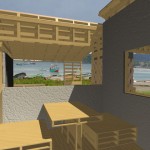Pallet House
21 years of civil war has left 1.5 million people in Somalia internally displaced. Pallet House is an inexpensive, efficient and easily assembled shelter for people displaced by natural or man-made disasters. A pallet structure can evolve from an emergency shelter into a permanent home with the addition of locally available materials such as, mud, plaster, concrete or corrugated sheathing. 60 pallets nailed together makes an 83 square foot shelter.
The Palette House is an inexpensive, efficient and easily constructed solution to the problem of housing people that have been displaced by natural disaster, plagues, famine, political and economic strife or war. This proposal won an Honorable Mention among hundreds of entries from around the world in a competition to design transitional housing for the returning refugees of Kosovo. The competition guidelines defined transitional housing as that which bridges the gap between temporary tent shelter and permanent home. It stipulated that the house needs to last about five years – the time it takes a Kosovar family to rebuild a typical stone house.
The Palette House is made of wooden shipping palettes. Palettes are versatile, recyclable, sustainable, easily assembled and are universally esthetically pleasing. Their transportation cost is negligible when used to carry shipments of clothing, food, medical supplies or other relief aid. A simple palette structure evolves naturally from an emergency shelter into a permanent house with the addition of more stable indigenous materials like rubble, stone, earth, mud, plaster and concrete.
Palettes or skids, typically used for shipping are inexpensive to make and can be pre-assembled by hand at a rate of 500-600 per day per worker. They are readily available in most countries around the world, and their size, strength and weight is specifically designed for transportation.
The evolution of one 10′ by 20′ shelter into a permanent home requires approximately 80 palettes nailed or strapped together and lifted into place. Total material costs including hardware equals approximately US$500. Tarps draped over the basic structure prevent water penetration until additional materials are collected. Within about a month enough debris, stone, mud or earth from the immediate surroundings can be gathered to fill the wall cavities and to cover the roof with corrugated metal, wood or straw. Where severe weather persists palettes may be pre-assembled with styrofoam insulation, vapor barrier, plywood or corrugated sheathing prior to shipping. As infrastructure is restored and cement or other materials become available, the filled palettes can be covered with stucco, plaster, or roofing tiles transforming the makeshift shelter into a permanent home within a year or two.
The palette module provides great flexibility in terms of configuration, allowing each family to build according to their own needs, be it simple patching of roofs, completion of a partially standing structure or an entirely new home. The size and layout of each home can evolve over time encouraging the natural reconstruction of family and village clusters as it has been for centuries throughout Southern Europe. The Palette House adapts easily to almost every climate.
Source: i-beamdesign.com











